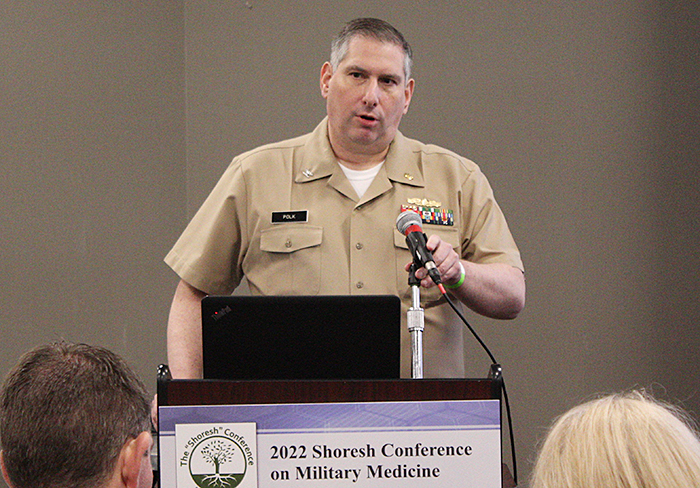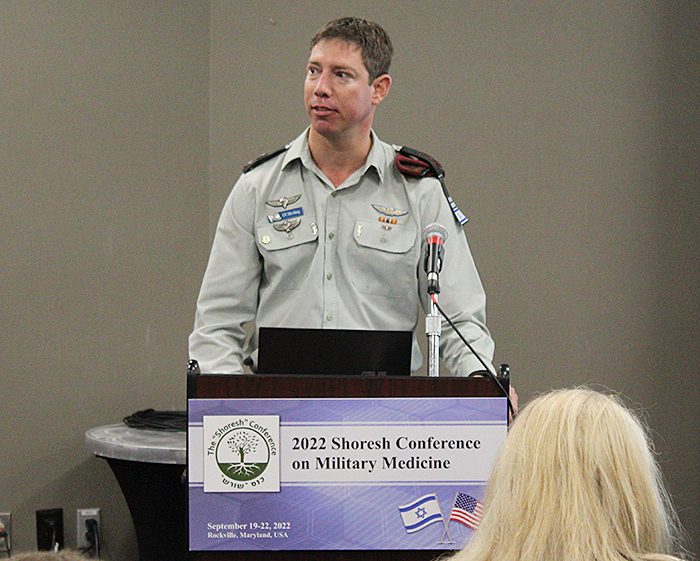'Constantly Evolving': Shoresh Charts Future of Combat Casualty Care

During a session focusing on the science of combat casualty care at the 2022 Shoresh Conference on Military Medicine, Capt. Travis Polk made it a point, over and over again, to note the importance of innovation – of new ideas and medical technology – to both U.S. and Israeli military forces in the coming years. As the director of the U.S. Army Medical Research and Development Command's Combat Casualty Care Research Program, Polk wanted the sizable crowd in attendance to understand the stakes of medical care on the battlefield of the future.
"The accomplishments of the past are just that – the accomplishments of the past," said Polk, a Navy trauma surgeon by trade, noting the success of the military trauma system during the recent conflicts in Iraq and Afghanistan. "Our next conflict will likely not look like what we just witnessed."
To that end, Polk provided an expansive review of CCCRP's wide-ranging capabilities while also laying out the fronts on which his research program is targeting for future innovation. Joined at the podium by his Israel Defense Forces working group chair Lt. Col. Ofer Almog, Polk pointed to game changing ideas and technologies in the specific areas of prolonged care, regenerative medicine and hemorrhage control as perhaps the most integral to maintaining the resilience of U.S. forces during future combat operations.
"We need to prepare for large-scale combat operations against a peer," said Polk, cutting quickly to the heart of his presentation. "Therefore everything we develop needs to be geared-to and compatible-with the battlefield."
As the U.S. military works towards the goal of developing a semi-autonomous (and eventually, perhaps even a fully-autonomous) medical care system for the Warfighter – in accordance with current modernization plans – the changing scope of the battlefield will continue to dictate medical care. According to Polk, advanced thermobaric and directed-energy weaponry will likely lead to an increase in so-called "combined injuries" (e.g. a gunshot wound combined with exposure to a chemical agent), which will necessitate even faster medical evacuation; efforts which could be complicated by the projected lack of U.S. air superiority in a future battlefield scenario. In these cases, prolonged care becomes an even more critical research area. To wit, during a discussion on the concept of "the tyranny of distance," Polk proposed a scenario in which a future casualty might be required to cross the Pacific Ocean before arriving at a higher role of medical care, noting that the entirety of the globe's land mass could fit comfortably inside the ocean's borders. Bottom line: longer evacuations will require new tools to allow medics to care for Warfighters for longer period of time.

In this regard – and as a perfect example of how both nations benefit from the others' presence at Shoresh – the IDF has considerable expertise in this area given that many of their members are stationed in the southern portion of their home country, far away from the civilian medical centers where all Israeli soldiers are, by rule, treated.
"We're not identical but we have the same problems," said Almog, who serves as the head of the Trauma and Combat Medicine Branch of the IDF Medical Corps, in a nod to the issue of prolonged care. "As a group we must be better at triaging at the point-of-injury. In some cases, we've been using techniques that were created many decades ago."
Almog's presentation focused on the importance of early experimentation for new technologies as a way for the IDF – which is considerably smaller in size than the U.S. military medical infrastructure – to continue to operate on the leading edge of medical care; the idea being to allow Soldiers to begin using burgeoning technologies as fast as possible to determine which features work, and which do not. Almog highlighted alternative blood products, pre-hospital trauma care and decision-making support as key focus areas for the IDF entering the week.
Speaking to the larger Shoresh crowd on the concept of medical innovation earlier in the day, Maj. Gen. Telita Crosland, U.S. Army Deputy Surgeon General, drove home those same points.
"If we do not imagine large and reach deep, we will not be successful," said Crosland. "We have to understand there is no end-state – we are constantly evolving."
For Polk, that evolution begins with taking current technologies – such as tele-presence and the ability to deliver blood via unmanned aerial vehicles – and refining or expanding upon them to meet the coming challenges. Technologies that help "up-skill" Soldiers (or, teach them how perform tasks they previously did not know how to perform) will be critical as well.
"We talk about the future battlefield, but we're not really talking about 'the future' are we?" said Polk. "This isn't just the fight for 2035 or beyond, it could be the fight tomorrow."














